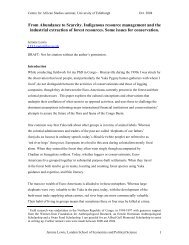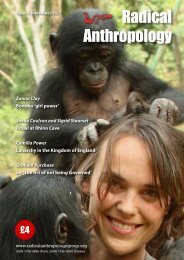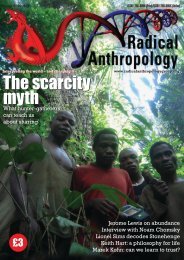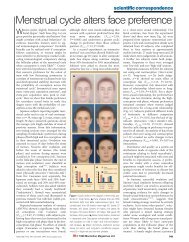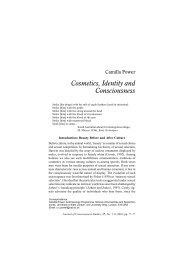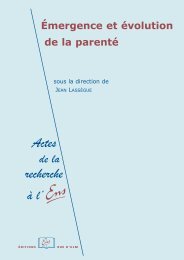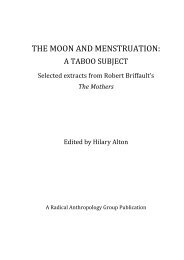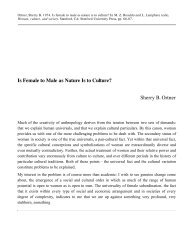Language and life history: A new perspective on the development ...
Language and life history: A new perspective on the development ...
Language and life history: A new perspective on the development ...
- No tags were found...
You also want an ePaper? Increase the reach of your titles
YUMPU automatically turns print PDFs into web optimized ePapers that Google loves.
Commentary/Locke & Bogin: <str<strong>on</strong>g>Language</str<strong>on</strong>g> <str<strong>on</strong>g>and</str<strong>on</strong>g> <str<strong>on</strong>g>life</str<strong>on</strong>g> <str<strong>on</strong>g>history</str<strong>on</strong>g>data to isolate comp<strong>on</strong>ents of <strong>the</strong> language faculty. Only an adaptati<strong>on</strong>istanalysis, of <strong>the</strong> sort seen in evoluti<strong>on</strong>ary psychology, can carve languageat its joints <str<strong>on</strong>g>and</str<strong>on</strong>g> lead to testable predicti<strong>on</strong>s about how language works.Locke & Bogin (L&B) begin <strong>the</strong>ir paper by describing <strong>the</strong> recent<str<strong>on</strong>g>history</str<strong>on</strong>g> of scholarship in language evoluti<strong>on</strong>. The key point <strong>the</strong>ydraw out is that <strong>on</strong>togeny has been largely ignored, <str<strong>on</strong>g>and</str<strong>on</strong>g> <strong>the</strong>iraim is to rectify this omissi<strong>on</strong>. What <strong>the</strong>y do not state is thatmost of <strong>the</strong> work has been <strong>on</strong> phylogeny; research has predominantlyfocused up<strong>on</strong> <strong>the</strong> evoluti<strong>on</strong>ary transiti<strong>on</strong>s that may or maynot have led to human language as it is now.Mapping out phylogenies is not <strong>the</strong> <strong>on</strong>ly use for evoluti<strong>on</strong>ary<strong>the</strong>ory. Evoluti<strong>on</strong>ary psychology (EP) is in <strong>the</strong> business of individuatingtraits through adaptati<strong>on</strong>ist analyses, such that organismsare looked at in terms of <strong>the</strong> ecology in which <strong>the</strong>y live<str<strong>on</strong>g>and</str<strong>on</strong>g> predicti<strong>on</strong>s are made about <strong>the</strong> kinds of psychological adaptati<strong>on</strong>s(mechanisms) required to meet ecologically relevant taskdem<str<strong>on</strong>g>and</str<strong>on</strong>g>s (Andrews et al. 2003; Dickins 2005). Sometimes this isd<strong>on</strong>e against a backdrop of hypo<strong>the</strong>sised envir<strong>on</strong>ments of evoluti<strong>on</strong>aryadaptedness, <str<strong>on</strong>g>and</str<strong>on</strong>g> such hypo<strong>the</strong>ses are generated from,am<strong>on</strong>g o<strong>the</strong>r things, comparative data. This kind of functi<strong>on</strong>alanalysis provides key c<strong>on</strong>straints for subsequent discussi<strong>on</strong> ofproximate mechanisms.If we accept that language has evolved, <str<strong>on</strong>g>and</str<strong>on</strong>g> <strong>the</strong>re is littlereas<strong>on</strong> not to, we can <strong>the</strong>n apply EP reas<strong>on</strong>ing to <strong>the</strong> subjectmatter – language itself. By carefully thinking through <strong>the</strong>adapted functi<strong>on</strong>s that language delivers we can begin to individuatecomp<strong>on</strong>ents of this faculty. Then, <strong>on</strong>ce we have an EP<strong>the</strong>ory of language we can, perhaps, begin to think about its phylogeny,for we know what has been selected for. This is a l<strong>on</strong>gproject, <str<strong>on</strong>g>and</str<strong>on</strong>g> not without methodological problems, not least <strong>the</strong>absence of fossil evidence; but anything else would run <strong>the</strong> riskof generating just-so stories. However, <strong>on</strong>ce <strong>the</strong> EP project hasbeen completed it is hard to imagine what use phylogenetichypo<strong>the</strong>ses could be put to o<strong>the</strong>r than to dem<strong>on</strong>strate that <strong>the</strong>already isolated adaptati<strong>on</strong>s could have evolved.Ontogenetic hypo<strong>the</strong>ses can be used slightly differently fromphylogenetic <strong>on</strong>es, in that <strong>the</strong>y can be tested in <strong>the</strong> laboratory<str<strong>on</strong>g>and</str<strong>on</strong>g>, in so doing, aid in <strong>the</strong> individuati<strong>on</strong> of psychological adaptati<strong>on</strong>s.N<strong>on</strong>e<strong>the</strong>less, before <strong>on</strong>e goes into <strong>the</strong> lab <strong>on</strong>e needs topropose a sound evoluti<strong>on</strong>arily based hypo<strong>the</strong>sis about how <strong>on</strong>togenywould pan out. Again, adaptati<strong>on</strong>ist analysis should come first.L&B appear to have operated a somewhat mixed strategy, but<strong>on</strong>e that mostly falls in line with <strong>the</strong> traditi<strong>on</strong> of speculating <strong>on</strong>phylogenies. Their initial observati<strong>on</strong>s about what language isclearly originate from thinking about its adapted functi<strong>on</strong>s. So,as with much c<strong>on</strong>temporary EP, <strong>the</strong>y see language as fulfillinga variety of social signalling tasks. What is more, <strong>the</strong>y moveaway from <strong>the</strong> traditi<strong>on</strong>al Chomskyan focus up<strong>on</strong> grammar<str<strong>on</strong>g>and</str<strong>on</strong>g> c<strong>on</strong>tent, <str<strong>on</strong>g>and</str<strong>on</strong>g> note that language is a many-str<str<strong>on</strong>g>and</str<strong>on</strong>g>ed communicati<strong>on</strong>system. They rightly point to <strong>the</strong> qualities of voice,pragmatic inference, <str<strong>on</strong>g>and</str<strong>on</strong>g> verbal fluency, am<strong>on</strong>g many o<strong>the</strong>rthings, as sources of signal <str<strong>on</strong>g>and</str<strong>on</strong>g> informati<strong>on</strong>. However, <strong>the</strong>y<strong>on</strong>ly use this insight to broadly define <strong>the</strong> aspects of language<strong>the</strong>y are interested in. After this, L&B go <strong>on</strong> to outlinevarious key features of language <strong>development</strong>, which <strong>the</strong>y inturn use to speculate about phylogeny. So, <strong>the</strong>y note that aswe develop from infancy to adulthood social c<strong>on</strong>texts becomemore complex <str<strong>on</strong>g>and</str<strong>on</strong>g> this is matched by increased communicativesophisticati<strong>on</strong>. In particular, <strong>the</strong>y claim that adolescence is aperiod of near-adult social complexity in which <strong>the</strong> rules ofadult <str<strong>on</strong>g>life</str<strong>on</strong>g> can be learnt <str<strong>on</strong>g>and</str<strong>on</strong>g> to some extent implementedwithout <strong>the</strong> cost. During this period, language develops suchthat grammar becomes more sophisticated, speech is morefluent, more <str<strong>on</strong>g>and</str<strong>on</strong>g> more pragmatic communicati<strong>on</strong> is engagedin, <str<strong>on</strong>g>and</str<strong>on</strong>g> <strong>the</strong> native language is modified. Adolescence sees <strong>the</strong><strong>on</strong>set of gossiping about o<strong>the</strong>rs, as well as “joking, deceiving,mollifying, negotiating, <str<strong>on</strong>g>and</str<strong>on</strong>g> persuading, with increases in <strong>the</strong>use of sarcasm” (sect 2.8). In brief, <strong>the</strong> social uses of languagebecome more prevalent.L&B discuss <strong>the</strong> possibility that human infancy has been foreshortenedby natural selecti<strong>on</strong> in order to allow maternalresources to be diverted to <str<strong>on</strong>g>new</str<strong>on</strong>g> offspring more rapidly, <str<strong>on</strong>g>and</str<strong>on</strong>g>that this in turn led to childhood. Children are semi-independent<str<strong>on</strong>g>and</str<strong>on</strong>g> require less care, <str<strong>on</strong>g>and</str<strong>on</strong>g>, importantly for L&B, are able toengage in verbal interacti<strong>on</strong>s with adults that will shape <strong>the</strong>irlinguistic <strong>development</strong>. It is during this period that what couldbe referred to as a Chomskyan basis for linguistic communicati<strong>on</strong>is established. L&B fur<strong>the</strong>r hypo<strong>the</strong>sise that <strong>the</strong> social practicefuncti<strong>on</strong>s of adolescence were directly selected for <str<strong>on</strong>g>and</str<strong>on</strong>g> thisallowed for <strong>the</strong> emergence of <strong>the</strong> o<strong>the</strong>r str<str<strong>on</strong>g>and</str<strong>on</strong>g>s of linguisticcommunicati<strong>on</strong> discussed above.L&B have essentially married detailed observati<strong>on</strong>s aboutlanguage <strong>development</strong> with a loose <strong>the</strong>sis about <strong>the</strong> phylogenyof <strong>on</strong>togeny, <str<strong>on</strong>g>and</str<strong>on</strong>g> without engaging in a detailed adaptati<strong>on</strong>istanalysis. They are undoubtedly right that <strong>on</strong>togeny is a productof natural selecti<strong>on</strong>, <str<strong>on</strong>g>and</str<strong>on</strong>g> <strong>the</strong>ir <str<strong>on</strong>g>life</str<strong>on</strong>g>-<str<strong>on</strong>g>history</str<strong>on</strong>g> approach, whichlooks at maternal trade-offs, makes evoluti<strong>on</strong>ary sense. But it isunclear what predicti<strong>on</strong>s we can now make about <strong>the</strong> kinds ofproximate mechanism underlying language that we could notmake prior to this argument. One reas<strong>on</strong> for this is <strong>the</strong> slightcircularity of <strong>the</strong> adolescence argument. By observing how adolescentsuse language, <str<strong>on</strong>g>and</str<strong>on</strong>g> assuming that this <str<strong>on</strong>g>life</str<strong>on</strong>g>-stage is aproduct of natural selecti<strong>on</strong>, L&B suggest that <strong>the</strong> social complexitiesof adolescence drove selecti<strong>on</strong> for <strong>the</strong> social signallingfuncti<strong>on</strong>s of language. But it is equally possible that socialcomplexities were able to emerge as a c<strong>on</strong>sequence of socialsignalling abilities. There is nothing in <strong>the</strong> current argumentthat can resolve this, <str<strong>on</strong>g>and</str<strong>on</strong>g> no obvious testable predicti<strong>on</strong>s aremade.The target article c<strong>on</strong>cludes by stating that <strong>the</strong> various str<str<strong>on</strong>g>and</str<strong>on</strong>g>sof language “were stitched toge<strong>the</strong>r in evoluti<strong>on</strong>, as <strong>the</strong>y are inmodern times, by <strong>the</strong> whole of human <strong>on</strong>togeny” (sect. 14).This is a different claim from <strong>the</strong> authors’ predominant <strong>on</strong>ethat <strong>development</strong>al stages were selected for – indeed, this is aclaim for a role for <strong>on</strong>togeny in phylogeny, <str<strong>on</strong>g>and</str<strong>on</strong>g> is perhaps <strong>the</strong>main point L&B wish to make. But it does not follow from anyof <strong>the</strong>ir observati<strong>on</strong>s. Developmental stages, as L&B have discussed,are <strong>the</strong> c<strong>on</strong>sequence of evoluti<strong>on</strong> through natural selecti<strong>on</strong>.Any <strong>development</strong>al “decisi<strong>on</strong>” made by natural selecti<strong>on</strong>will have c<strong>on</strong>sequences that in turn may provide selecti<strong>on</strong> pressures<str<strong>on</strong>g>and</str<strong>on</strong>g> lead to phenotypic change, but this is not coded into <strong>the</strong><strong>development</strong>al process. In this way, <strong>on</strong>togeny does not stitchtoge<strong>the</strong>r various capabilities in phylogeny, but ra<strong>the</strong>r specific<strong>on</strong>togenetic pathways are selected for <str<strong>on</strong>g>and</str<strong>on</strong>g> this establishesfur<strong>the</strong>r selecti<strong>on</strong> pressures, <strong>the</strong> outcomes of which are readilyobservable in c<strong>on</strong>temporary <strong>development</strong>.L&B are right to discuss <strong>on</strong>togeny <str<strong>on</strong>g>and</str<strong>on</strong>g> right to think about <strong>the</strong>multiple str<str<strong>on</strong>g>and</str<strong>on</strong>g>s of language, but <strong>the</strong>y should have moved awayfrom historical speculati<strong>on</strong> <str<strong>on</strong>g>and</str<strong>on</strong>g> toward EP if <strong>the</strong>y wished tohave made substantive <str<strong>on</strong>g>and</str<strong>on</strong>g> testable claims about <strong>the</strong> nature of<strong>the</strong> language faculty.The evoluti<strong>on</strong> of language: Present behavioralevidence for past genetic reprogramming in<strong>the</strong> human lineageRobert B. EckhardtLaboratory for <strong>the</strong> Comparative Study of Morphology, Mechanics, <str<strong>on</strong>g>and</str<strong>on</strong>g>Molecules, Department of Kinesiology, Pennsylvania State University,University Park, PA 16802.eyl@psu.eduAbstract: <str<strong>on</strong>g>Language</str<strong>on</strong>g> <str<strong>on</strong>g>and</str<strong>on</strong>g> <str<strong>on</strong>g>life</str<strong>on</strong>g> <str<strong>on</strong>g>history</str<strong>on</strong>g> can be related functi<strong>on</strong>ally through<strong>the</strong> study of human <strong>on</strong>togeny, thus usefully informing ourunderst<str<strong>on</strong>g>and</str<strong>on</strong>g>ing of several unique aspects of <strong>the</strong> evoluti<strong>on</strong> of species.The operati<strong>on</strong>al principles outlined by Locke & Bogin (L&B)284 BEHAVIORAL AND BRAIN SCIENCES (2006) 29:3



